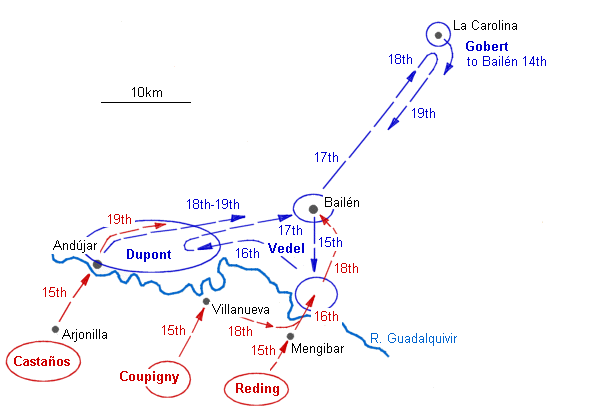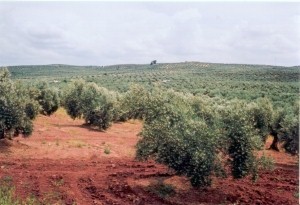
As part of Napoleon's plan to subjugate Spain in May 1808, Dupont was sent into Andalucía with 13,000 troops to take Córdoba and Sevilla. Dupont's force had few veteran troops and as such was quite inadequate for the task. Oman remarks that it was "a military crime of the first order to send 13,000 troops of this quality on an important expedition." Dupont reached Andújar on 15th June to find Andalucía in a state of revolt. Pressing on towards Sevilla, his troops ravaged the city of Córdoba despite having taken it practically unopposed. By this time, Spanish insurgents had succeeded in cutting the French line of supply back to Madrid at the Despeñaperros pass, prompting Dupont to order an immediate withdrawal back to Andújar. For a month he remained there largely inactive, time which the Spanish general Castaños made good use of to assemble a 34,000-strong army in Andalucía. A week after Dupont had returned to Andújar, a 6,000-strong French force led by Vedel broke through to La Carolina. In light of the threat posed by Castaños, Dupont could have prudently withdrawn to Bailén at this point, leaving Vedel to hold open the Despeñaperros pass. Instead he chose the flawed option of attempting to hold the line of the Guadalquivir river from Andújar to Mengibar, and ordered Vedel forward to Bailén. By 7th July, Dupont had been further reinforced by some 5,000 troops under the command of Gobert.  Taking the initiative to attack, Castaños deployed two divisions under the command of Jones and La Peña in front of Andújar on 15th July while divisions under Coupigny and Reding probed river crossings at Villanueva and Mengibar. In a gross misjudgement of the relative threats posed by Castaños and Reding, Vedel led the bulk of his division westwards towards Andújar. On the morning of 16th July, Reding forded the river near Mengibar and defeated a 4,000-strong force under Gobert, the remnants of which fell back first to Bailén and then to La Carolina. News of Gobert's defeat induced Dupont to split his forces, sending Vedel to Bailén with orders to force Reding back across the Guadalquivir. Finding Bailén devoid of troops, Vedel mistakenly drew the conclusion that Reding had by-passed the town to seize the Despeñaperros pass and set off in pursuit, joining what was left of Gobert's force at La Carolina on the morning of 18th July. Reding, in fact, had remained near Mengibar and advanced on Bailén only after joining forces with Coupigny. As Dupont finally abandoned Andújar on the evening of 18th July, 14,000 Spanish troops were already occupying the range of hills west of Bailén. (See footnote.) In the early hours of 19th July, Dupont's leading brigade under the command of Chabert encountered Spanish outposts west of Bailén. Quite unaware that two Spanish divisions blocked his path, Chabert sent his 3,000 men against the Spanish positions south of the road. Coupigny's division easily threw back the attack. Dupont, fearful now of being attacked from the rear by Castaños, ordered a fresh attack regardless of the fact that many of his troops had yet to reach the battlefield. On the French right, Privé's heavy cavalry brigade drove through two Spanish battalions before being forced to withdraw through lack of infantry support. On the left of the cavalry, Chabert's brigade was again repulsed. North of the road, 2,000 Swiss mercernaries of Schramm's brigade were thrown back by Reding's division.
At 12.30pm Dupont, finally drawing together all the troops at his disposal, led a last, desperate attack directly against the centre of the Spanish line. Spearheading the attack, the veteran Marines of the Guard were practically obliterated in fighting their way up to the Spanish artillery line. Dupont himself was wounded and rode to the rear as the whole attack disintegrated. At the same time, the surviving troops from the Swiss battalions in Schramm's brigade deserted to the Spanish. As the exhausted, dehydrated French troops sought shelter in the olive groves, La Peña's division closed in on their rear. With his army facing annihilation, Dupont sued for a ceasefire at 2pm. Vedel - having finally returned from La Carolina - began to attack Reding's positions east of Bailén at around 5pm but halted on receiving orders from Dupont. The fighting was over. After prolonged negotiations, Dupont surrendered on condition that his men would be shipped back to France. Over 23rd-24th July, 17,600 French troops laid down their arms; nearly 2,000 more lay dead or wounded on the battlefield. Spanish casualties numbered less than 1,000. Shamefully, the Spanish reneged on the agreement to return the surrendered troops to France. Although Dupont was released along with his senior officers, his men were consigned to the horrors of the desolate Isla de Cabrera, south of Mallorca; fewer than half survived. The battlefield at Bailén is neither easy to find nor amenable to exploration. Travelling from Córdoba on the NIV-E5, exit at the 299km junction (Bailén) and immediately double-back on a minor road signposted to El Burguillo. Cross over the motorway and take the minor road north at the roundabout then take the right fork (not signposted). The road runs parallel to the line of hills held by Reding's division. The best viewpoint is probably just short of the hilltop 1km from the fork. A dirt track (not for the unadventurous) less than 1km further on leads up to the high ground and on to Bailén. "A History of the Peninsular War, Volume I" by Sir Charles Oman, published by Greenhill Books 1995, ISBN 1853672149. Detailed map of the Battle of Bailén courtesy of The Napoleon Series. This account is based on Oman's description of the battle. It has recently been suggested that the Spanish army at Bailén was initially largely deployed on the lower ground closer to the town (see, for example, Charles Esdaile's "Peninsular War" published in 2002). I would very much like to hear of other accounts or maps of the battle. © Andrew C Jackson 2001-2004
|

